I’ve written about my summer, winter and fall resources, but this post on spring special education resources got waylaid last year by the closing of school. I love to make seasonal resources to allow students to work on the same concepts across the year, but with different thematic material. And as spring approaches, it’s a time to pull out the bright and colorful spring themed activities to get the students focused on the work, instead of focused out the window.
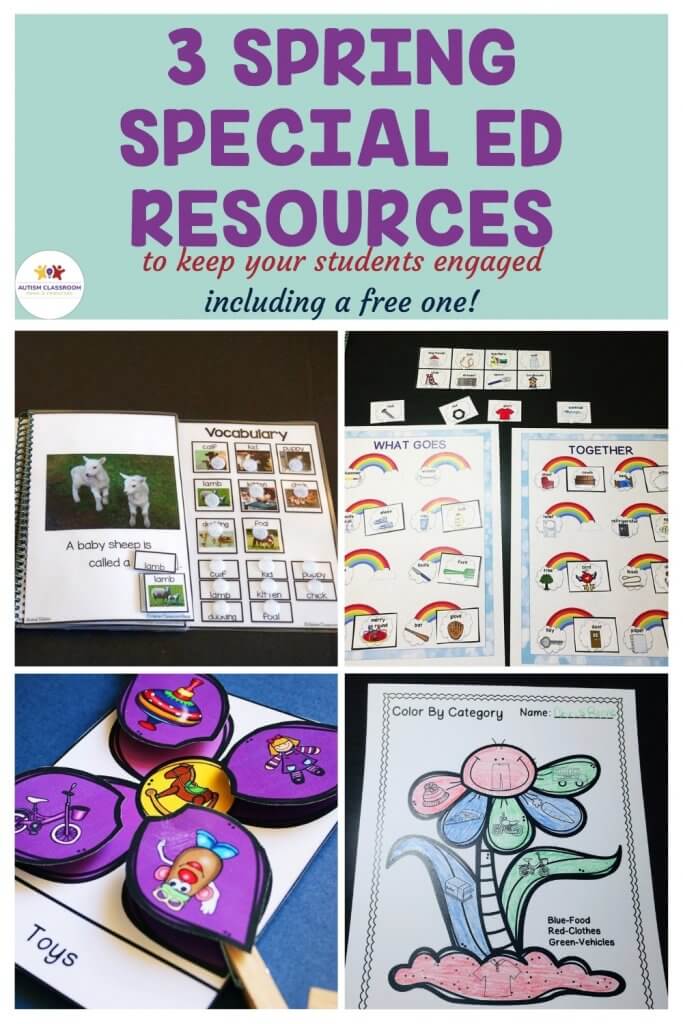
So in today’s post I’m sharing pictures and overviews of 10 different resources that are all designed with spring themes. I’ll share the students they are designed to help, the skills they target, what is included, and ideas about how I use them. And of course I’ll share where you can find them as well.
#1 Special Education Resource: Spring Interactive Books
When talking about spring special education resources, I always have to start with my interactive books. Interactive books are my babies because they are the first thing ever published (before I ever heard of TpT). I’m particularly fond of this set of interactive books because I love the animal babies book that is included with real photos. I was inspired when I used to take my mom to a lake outside her home, and we saw a family of ducklings walk by.
Who Are They For?
These books are great for all ages. In fact, this set includes some books, like the spring cleaning book, that would be great for older students. But is perfect appropriate for younger students helping to clean.
What Skills Do They Target?
The spring interactive books focus on spring vocabulary focused on gardening, animal babies, spring cleaning, and signs of spring. In addition to vocabulary, I talk about literacy goals that can be targeted with interactive books in this post. If you have students working with augmentative communication devices, the AAC goals from this post match perfectly with this set of books as well.
What’s Included in This Spring Special Education Resource?
As with all my seasonal interactive books, this set includes 5 interactive books with moveable pictures and words. The books are written at approximately a first to second grade reading level. Some books target nouns, some nouns and verbs and some primarily verbs.
- Spring Cleaning
This illustrated book focuses cleaning materials for spring cleaning the house. Vocabulary targeted includes: sponge, mop, washing machine, gloves, vacuum cleaner, feather duster, and broom. At the end of the book, students can choose the yes or no visual to answer, “Do you help your family clean the house?
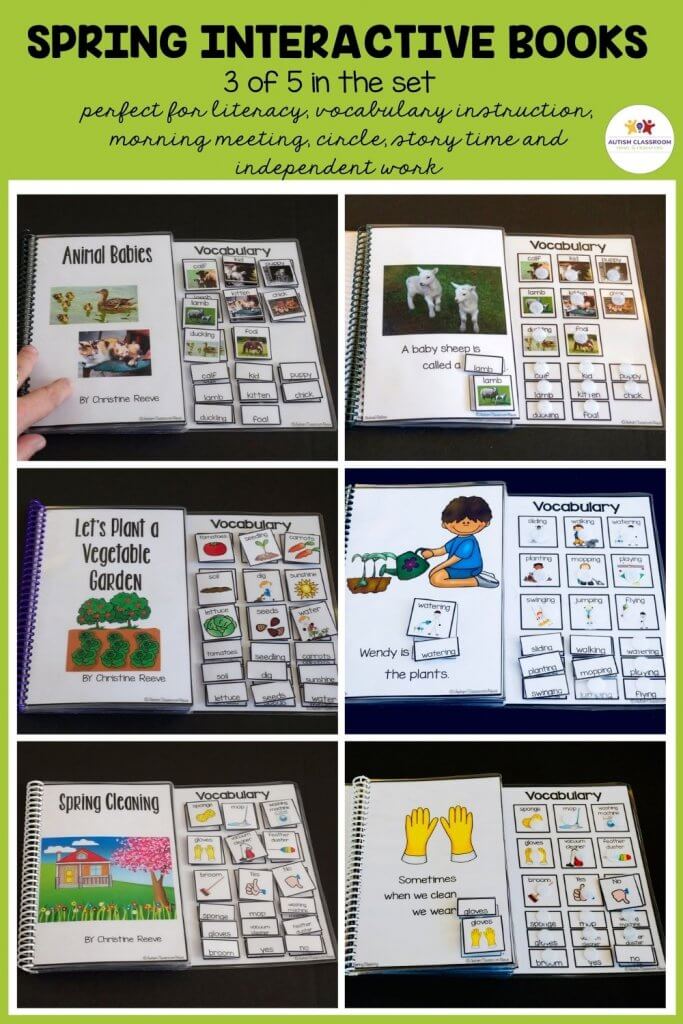
- Animal Babies
This photographic book focuses on the names of baby animals. The pictures in the book are of the baby animal and the pictures the student matches have a grown animal and baby to help differentiate animals that look similar as babies (e.g., sheep vs. goats). Vocabulary targeted include: duckling, kitten, puppy, calf, chick, kid, lamb, and foal.
- Signs of Spring
This illustrated book focuses on the early signs of spring including snow melting, flowers blooming, leaves turning green. It also includes yes and no for answering a question at the end whether the student likes spring. Vocabulary targeted includes: flowers, butterfly, snow, rain, green, leaves, seedling, yes, no. Some pictures are identical and some are not.
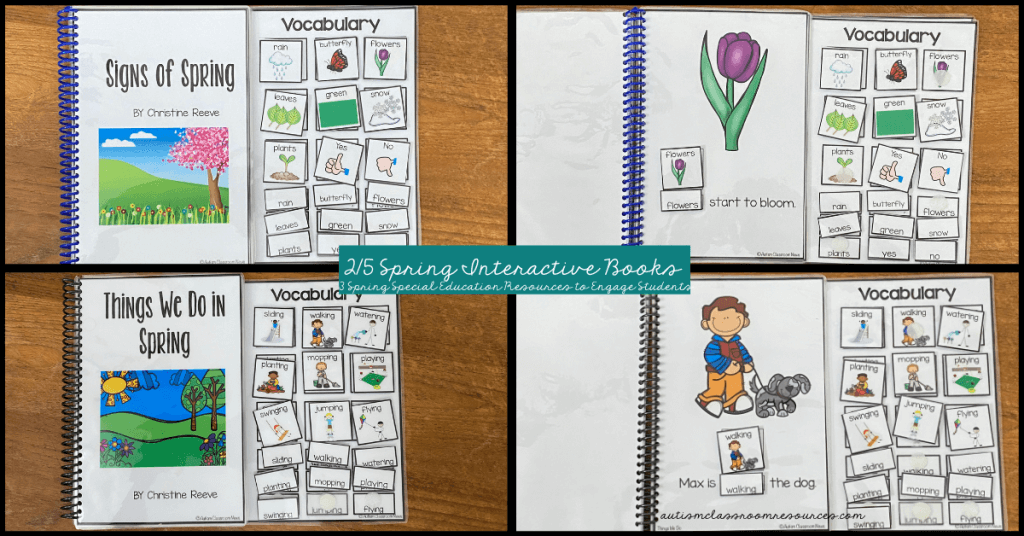
- Things We Do in Spring
This illustrated book targets verbs and depicts common activities that people do in the spring. Verbs targeted include: playing (baseball), planting (flowers), mopping, swinging, jumping (in puddles), watering (plants), walking (the dog), flying (a kite), and sliding (on a slide).
How I Use This Spring Special Education Resource
I like to use these books in morning meeting or circle time, story time, and small group or 1-1 instruction on reading skills. You can read them to a group and have the students each match a picture to the page when we get to them. We can do that in morning meeting or during reading instruction.
Once students have learned the book, you can add it to their independent work system to practice the skill. The great thing about the matching component of the book is that it will stay together with Velcro and you can check their work. And that makes it perfect for structured teaching and practice.
And finally, these interactive books are great for students to work with peers. Do you have a peer helpers who come into your self-contained classroom to interact with your students? Or do your students go into the general education classroom and you are trying to find activities for them to engage with peers? These books a good solution. Peers can read them and students who are nonverbal can participate/read by matching the words or using an AAC device. If you are looking for more ways to use interactive books, check out this post or this one for even more ways.
#2 Spring Special Education Resource: Spring RFFC Activities

The next spring special ed resource are activities for practicing receptive vocabulary by feature, function, and category. Working on receptive vocabulary beyond simply identification is important so that students can follow directions provided with more extensive detail. And it helps lead to more expressive language that is richer in detail. And I don’t know about you, but these days, most of the time I need someone to get something for me, it sounds a lot like, “Could you get me the…the…from the fridge…the white thing with a yolk and a shell.” Yea, I meant an egg, but could not remember the word. That’s where my brain is. But if you know your features, you could figure it out.
Who Is The Special Education Resource For?
These materials are perfect for preschool and elementary early learners working on expanding their knowledge of vocabulary. They are a great companion to ABA programs, discrete trials and speech therapy. These could be used in middle school and with older students, but the itmes are not specifically geared toward older learners.
What Skills Do They Target?
Using file folders, color by code, and sorting activities, these activities assist with teaching students to identify everyday items by characteristics (e.g., color, features), functions, or by category. They are also great for working on wh- questions, like “What do you see that barks?” or “Where is the orange one?” the following specific skills. In addition, I’ve cross-listed the skills and items with common ABA curricula items that you can see in the picture below. And you can find downloadable IEP goals and more description of targeted skills in this blog post about the summer set.
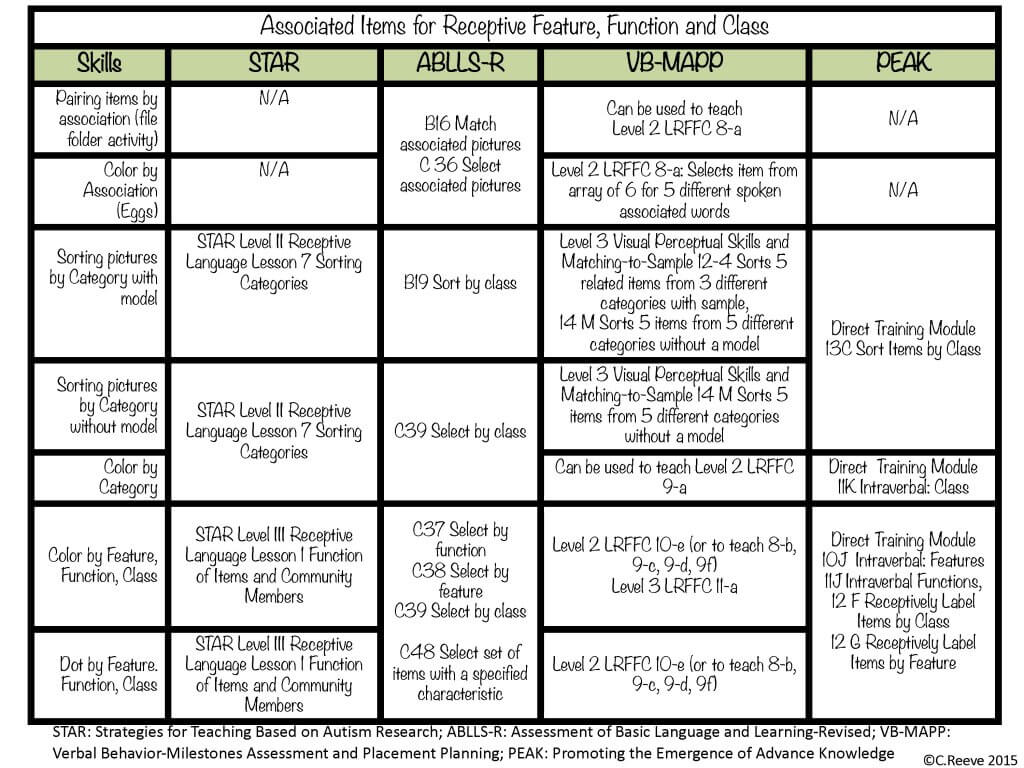
- Pairing items by association (i.e., what goes together-shoes/socks)
- Select by association
- Sorting pictures by category with a model
- Sorting pictures by category without a model
- Select by category
- Select by feature, function and class
What’s Included in This Spring Special Education Resource?
This set of materials uses a combination of reusable activities (i.e., file folders and sorting mats that get laminated and re-used) and worksheets. The worksheets are great for easy to grab activities. They also are useful for permanent work product / tests for data collection. The worksheets can be used with TpT’s Easel tool to be completed through a learning management system like Google Classroom on a tablet or computer as well. This makes them useful for distance learning.
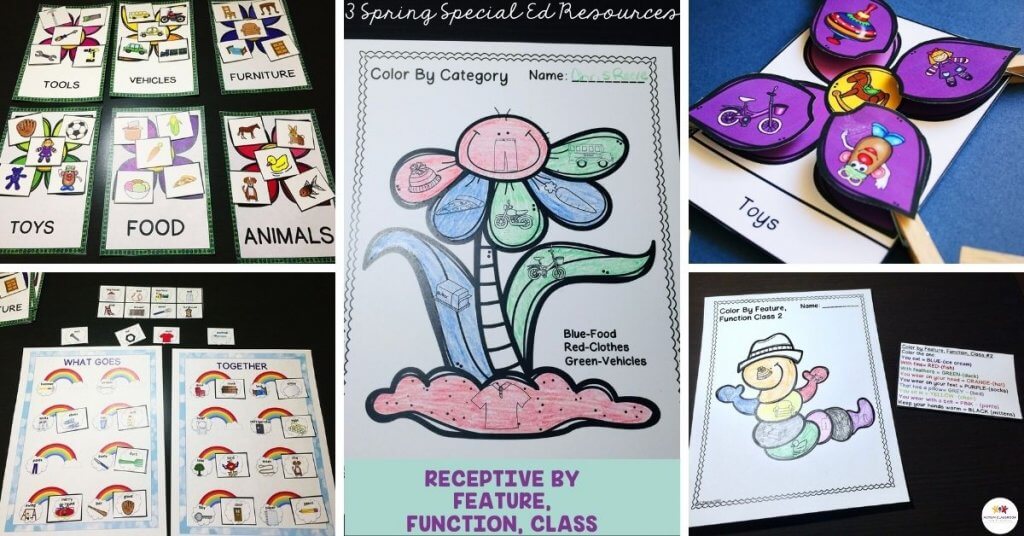
- a file folder for matching associated items (e.g., nail to hammer)
- 1 set of sorting activities by class/category with a model with up to 5 categories
- a set of sorting activities by class/category without a model with up to 7 categories
- 5 print-and-go sheets that students color parts by associated items
- 5 print-and-go sheets that students color by category pictures
- 5 print-and-go color by feature, function and class sheets to be used in direct instruction
- 10 black and white print and go sheets that students use bingo markers or stickers to identify multiple items with specific features, functions or class
- 10 color sheets that can be re-used with chips or coins to cover multiple items by specified feature, function, or class (the same as the black and white but with items rearranged)
How I Use This Spring Special Education Resource
These materials make great companions for ABA programs, discrete trials instruction and speech therapy. They are useful for the direct instruction themselves or for practice work in between instruction sessions. I like using them when doing small group instruction so that a student can work semi-independently, while I do instruction with another student. Once students master the skills, they are great activities to put into their independent work systems.
#3 Free Spring Life Skills Worksheets
And today’s third spring special education resource is a free one for you in the resource library. The spring life skills worksheets are 5 worksheets. Two focus on telling time and 2 focus on sorting food by whether they come from an animal or plant. Finally 1 worksheet has them sort vegetables from flowers.
These are perfect for students on a life skills curriculum of any age and any students working on time. The sorting worksheets for food are similar to the ones found in my nutrition unit that you can see more of in this post. These are great for direct instruction and for independent work, depending on students’ skills.
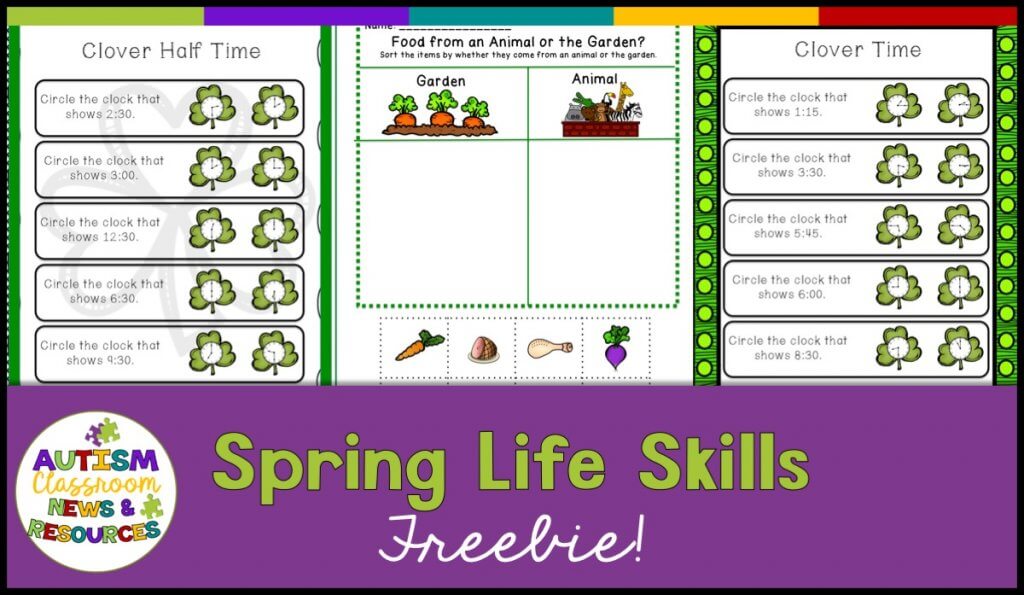
So make sure to grab these in the resource library below. I will be back with more spring resources in another post, focused more on younger students. In the meantime, I would love to hear what your favorite resources are to pull out and engage your students in the spring. So hop over to the free Facebook group for Educators and join in the discussion.
sign up for free tips each week in your inbox and Grab a free Spring Life Skills from the resource library
Grab them from the Free Resource Library. Click below to navigate or join the free library.

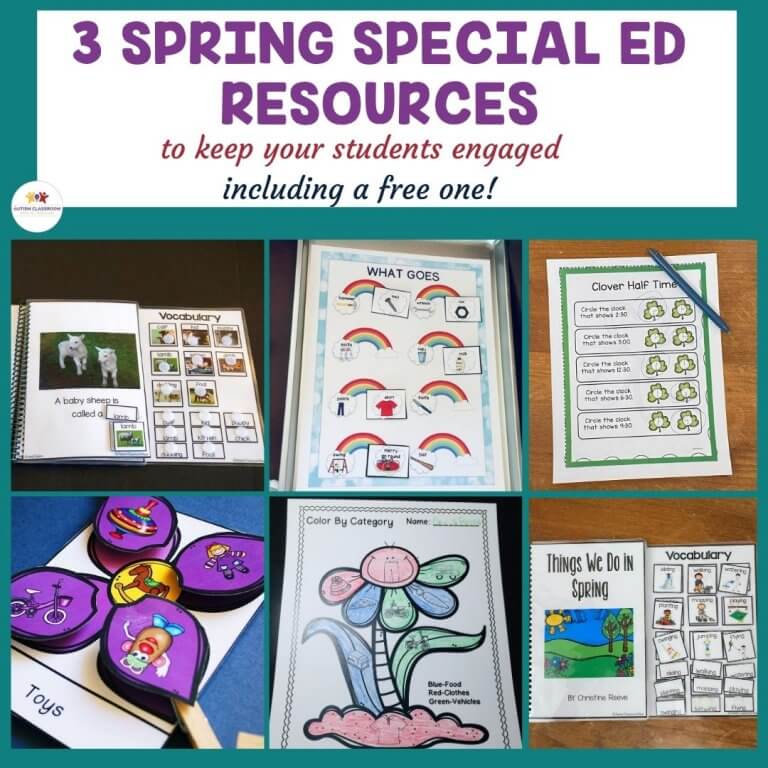



![Summer resources to help survive the end of the year in special education [picture-interactive books with summer themes]](https://autismclassroomresources.com/wp-content/uploads/2018/05/SUMMER-RESOURCES-ROUNDUP-FEATURE-8528-768x768.jpg)

